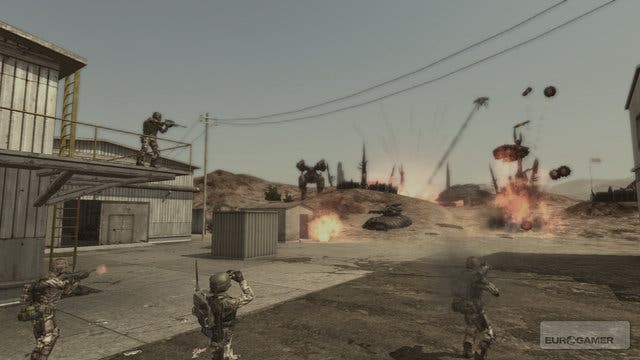Enemy Territory: Quake Wars
Lust in translation?
On the plus side, the game benefits from an array of excellent ground and air vehicles and static units that keep things interesting and enhance the overall strategic depth. GDI forces rely on more conventional tanks, APCs, and hover-copters, but the Strogg tech is altogether more exciting, with jetpack-style Icarus units soaring high into the air to bomb targets from a distance, and gigantic, clanking mech-walkers and insectoid Tormentor aerial attack craft raining death. Careful use of the various anti-air, anti-personnel and anti-vehicle units can often neutralise even the most determined assault with a bit of forethought.
Arguably, the most fun you have with Quake Wars is this process of experimentation as you work though each class and approach each map a slightly different way. With the game's inability to properly tutor you in its hidden depths an undoubted annoyance at first, the payback for sticking with the game is finding out all sorts of evil you can wreak upon your opponent once you explore what's available. It's not a game many people will appreciate in the first few days, but persistence reveals it to be a real slow-burner.
Inevitably, with so many shooters crowding out the console market, it will be the underwhelming first impressions that put many people off. Despite looking pretty solid, the muddy war of attrition isn't as eye-catching as it could be - and certainly compares unfavourably to a steroid-pumped PC game - but you could have guessed that without so much as glancing at a screenshot. The target was to get the 360 version to stand shoulder to shoulder with the 'recommended' PC spec, but fashioning the "Megatexture" tech to the 360's innards without major compromise appears to have been just out of Nerve's reach.
Initially, Quake Wars feels like a solid, regulation port. The controls, despite what you might have heard, feel great, and everything's been thoughtfully mapped for joypad play. But the more you play, the more the little glitches start to add up. Apart from the fact it's vying for the Brownest Game Ever award, you'll also notice a subtle abundance of scenery pop-in, with near-ground grass and bushes routinely appearing mere feet away from you, while often gigantic plumes of smoke suddenly appear from nowhere.

As nit-picky as this might sound, we'd probably forgive it if the action was silky smooth and the frame-rate consistent - but it's plainly not. When mass explosions are kicking off, smoke effects can drag the action down to single digits for several seconds. Offline against the bots this won't feel like a major issue, but if you're unlucky enough to fall foul of this online, then the action dips into slideshow territory and it becomes a lottery as to whether you'll stay alive or not.
There's no doubting that all 12 maps are well-designed, reasonably intricate and work perfectly within the relative confines of eight-on-eight multiplayer, but they're intensely boring to look at. Any tech that boasts Megatexture really needs to back such lofty claims with some hard evidence - such as wonderfully lit, stunningly detailed, and interestingly crafted environments that rival the very best out there. Instead, Quake Wars looks very much like everything else. Almost criminally (if you're a Quake fanboy, at least), it's not even sporting the same style as Quake, preferring an overly familiar ragged, gritty military look that a dozen other shooters have managed in the last year alone. That's not to say the game's especially deficient, either, but it's a tired look and feel that doesn't wow in any way.

